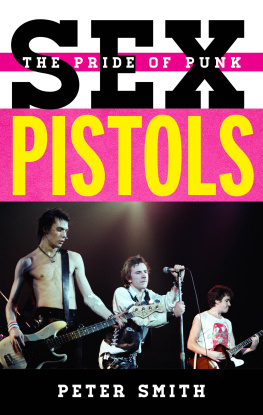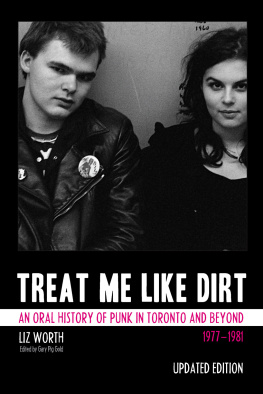For my grandmother Mary
and my parents, Lynn and Walt.
Well, I guess its time for the slamdance contest.
That sounds dangerous.
Oh, its not dangerous, its going to be a lot of fun.
Mels Rock Pile, SCTV
INTRODUCTION
Hi, I was wondering if Ken Chinn was there?
Ken Chinn... Is that the guy they call Chi Pig?
Oh, yeah. Thats him.
He wanders in and out, we just kind of act like his answering service. Let me see if hes around.
Hes not. Ken Chinn is the vocalist for one of Canadas most infamous punk exports, that great Edmontonian monument to weirdness, SNFU. To get in touch with him, you have to call his favourite bar in Vancouver in the early afternoon. If hes around, you might get about five minutes with him before someone else needs to use the line. It is, after all, a business. And, as legendary as Ken Chinn might be to some, to the Gastown bartenders Ive been calling once a day for three weeks, hes still just a barfly without a cell phone.
Canadas punk history is a cloudy one. Bands lived and died in isolation. Recordings are sparse; listenable ones are sparser. Despite thriving music communities in cities like Ottawa and Calgary that flourished at the same time as those in London and New York, Canadian punk bands never caught the attention of international media the way their peers to the south and across the Atlantic did. Theirs was a quintessentially modest Canadian existence, just with more stories about amyl nitrate and sex in public. You wont hear the bombastic opening chord to a Lowlife song at a baseball game in Milwaukee, and the lead singer of Electric Vomit wont be on TV selling you butter between sports and weather on the evening news. And so it goes that Canadas first wave of punks, alienated kids living in alienated cities, have been disappearing from our collective cultural memory, disappearing from our record stores, and, in some cases, just disappearing.
It is an unfair fate. Consider that Zoom, a precursor to both the Diodes and the Viletones, was amongst the first punk groups in the world to release their own record. Torontos the Curse were the first North American all-female band of punks first wave. D.O.A. created the continental do-it-yourself touring network still used today and were the first band to officially use the word hardcore to describe their sound. Pre-punk bands like the Dishes laid the conceptual groundwork for queercore groups like Pansy Division and Limp Wrist in the 90s, while in Regina the Extroverts established the citys first live venue to only promote bands playing original music. It stands to this day.
The list goes on. But the legacy of these bands goes far beyond the dim corners of dive bars and dusty shelves of record collectors. Punk in Canada was a transformative cultural force that challenged every sleepy, safe city from Victoria to St. Johns. Its not Pierre Bertons Canada, but its just as real and just as crucial. And its got way, way more vomit.
I began to piece this book together in 2006, while still studying at Ryerson University. Essentially, I convinced the school administration to let me begin work on the project in my final year as a substitute for a fully realized academic paper. Mercifully, I had landed one advisor with a weakness for the Viletones discography and another who was simply willing to follow me into the dark; the assignment I handed in at the terms end amounted to little more than hundreds of pages of interview transcription. I graduated.
My very first interview that year, conducted over the phone from my Jarvis Street apartment, was with Bev Davies, the Vancouver-based photographer whose lens helped define the stark visual aesthetic of the early west coast scene. Her candid photos of bands like the Subhumans and D.O.A. first caught my eye in high school while flipping through the pages of Chart. I knew about these bands, but I had never seen visuals like this, never heard about the concept of fuck bands with names like Rude Norton and Victorian Pork. In an interview with iconic radio and TV personality Nardwuar the Human Serviette, Davies talked about guys like Randy Rampage in the same breath as Lemmy from Motrhead, and her photos showed musicians whipped into a frenzy, part of a culture of punk I had yet to really tap into.
Soon after uncovering Davies photos, I started writing for Exclaim! , trading my adolescent fanzine for a shot with a national music magazine and, under the scrutiny of a great no-bullshit editor, started to take my punk rock fandom more seriously. It wasnt enough to trace my garbage-can ninth grade emo back to the basements of Washington, D.C. It was wasnt enough to follow the roots of my tenth grade white-washed skate punk to the beaches of California. I knew that something had come before me and my record collection in suburban Etobicoke, and looking at Davies photos in the worn-out pages of Chart , it was obvious where to start.
When I was still living in my parents house, I would take the subway downtown every weekend, heading straight for Rotate This! on Queen Street West and spending hours poring over their racks of vinyl and CDs before heading home with whatever I could afford that week on my pin monkey income. I immersed myself in the music, the art, and the knowledge that I was starting to touch on something secret, special, and forgotten. By the time I had a job and was living downtown, I would spend my Sunday afternoons with the clerks at the landmark Sam the Record Man on Yonge, listing off records I needed ordered into the store. The entire Sudden Death catalogue. Whatever Sony had kept in print from the Diodes. All the Teenage Head records. Anything Canadian, anything even tangentially punk.
There was a glaring hole in my acquisitions, though. Most of the early Toronto bands had their licensing swept up by a local archivist in the late 90s and the albums he had produced were no longer in print. When I finally tracked him down, he invited me over to his house in the Junction. He went into his basement and came back up with an armful of records. In his living room, he spread out the complete discographies of bands like the Mods, the Curse, the Viletones, and the Ugly for me to choose from. I bought everything.
Within a few years of my university graduation, I had hundreds of hours of interviews on tape. I had a box full of fanzines, books, albums, and photocopies from the library. I had a hard drive full of movies, photos, and archived news clippings. I had bootlegged an academic copy of the 8 mm Ross McLaren film Crash n Burn from the back of a classroom at Ryerson, talked about car-surfing with Stiv Bators while staring at the city from the sixty-third floor of a Bay Street office tower, and watched more than one person get so drunk that they couldnt stand. I had made more friends that I ever thought possible, been threatened with a lawsuit, and been lent records worth more than my life by people who had no reason to trust me.
This book was put together, appropriately, all over this country. It started in a lecture hall at Ryerson University and grew inside my overheated apartment above a meth lab on Ossington Avenue. It followed me when I first visited Winnipeg in 2007 and saw the majestically decrepit Royal Albert Arms with my own eyes, a dive where Hsker D recorded the B-side to Eight Miles High and local greats Personality Crisis built their legend. On a family vacation I looked at the site where the Smiling Buddha once stood on East Hastings Street in Vancouver, in the centre of the poorest postal code in the entire country and the highest concentration of HIV-infected individuals in North America. Parts of this book were literally written on the road, on a laptop in the back of an RV rumbling across the eastern seaboard of the United States during one of the worst winters on record. Mostly, it was written in my kitchen, late into the night, an endless loop of the Dayglo Abortions, Diodes, and Dishes on my headphones.











